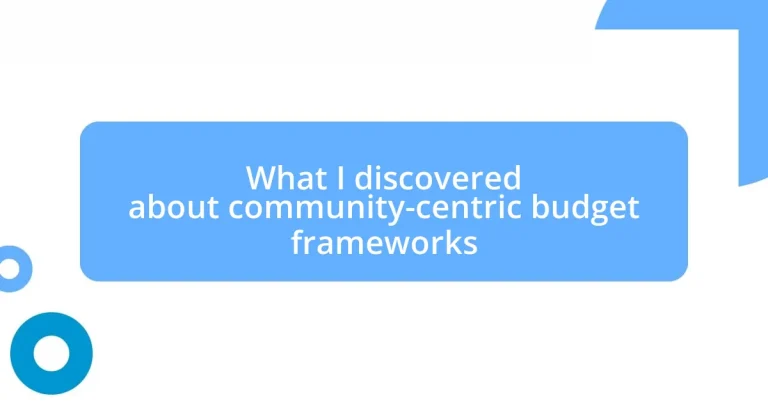Key takeaways:
- Community-centric budgets emphasize transparency, inclusivity, and equity, allowing marginalized voices to influence financial decisions.
- Stakeholder engagement, accountability, and adaptability are key principles for effective budgeting frameworks.
- Utilizing technology and structured feedback mechanisms can enhance community participation and ensure diverse input in budget discussions.
- Real-life case studies demonstrate how participatory budgeting fosters ownership and aligns financial resources with community values and needs.
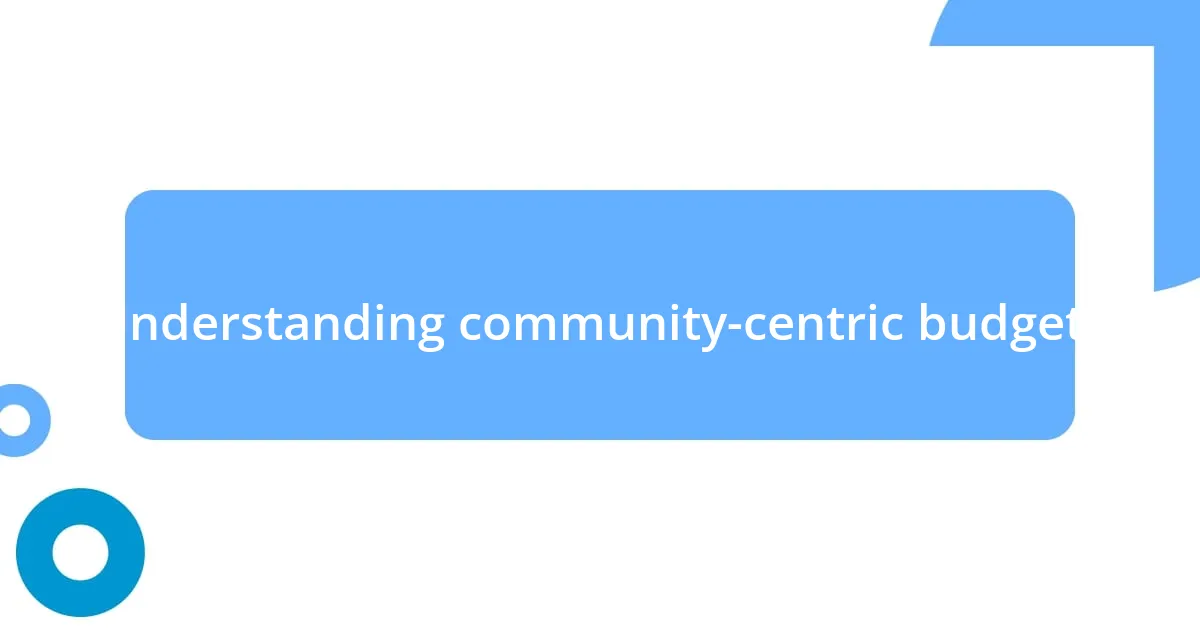
Understanding community-centric budgets
Understanding community-centric budgets is more than just allocating funds; it’s about prioritizing the needs and voices of those affected by financial decisions. When I first encountered this concept, it felt like a revelation—imagine a world where budgets reflect the true priorities of a community rather than top-down dictates. Have you ever felt unheard in a decision-making process? That’s what makes community-centric budgets so significant; they empower individuals by giving them a stake in the decisions that shape their lives.
At their core, these budgets emphasize transparency and inclusivity. I remember attending a local budgeting meeting where residents shared their concerns about aging infrastructure. It was a moment of collective realization that when community members actively participate, the outcomes are not only more aligned with actual needs but also foster a sense of ownership. Isn’t it powerful to consider how local perspectives can reshape financial strategies?
Moreover, community-centric budgets can promote equity by addressing historical injustices within resource distribution. It’s striking to see how such a framework can prioritize marginalized voices, ensuring everyone benefits. Reflecting on this, I think about how budgets could evolve if we consistently asked ourselves, “Whose needs are we meeting, and who is left behind?” This approach transforms budget discussions into living dialogues, rich with the pulse of community aspirations.
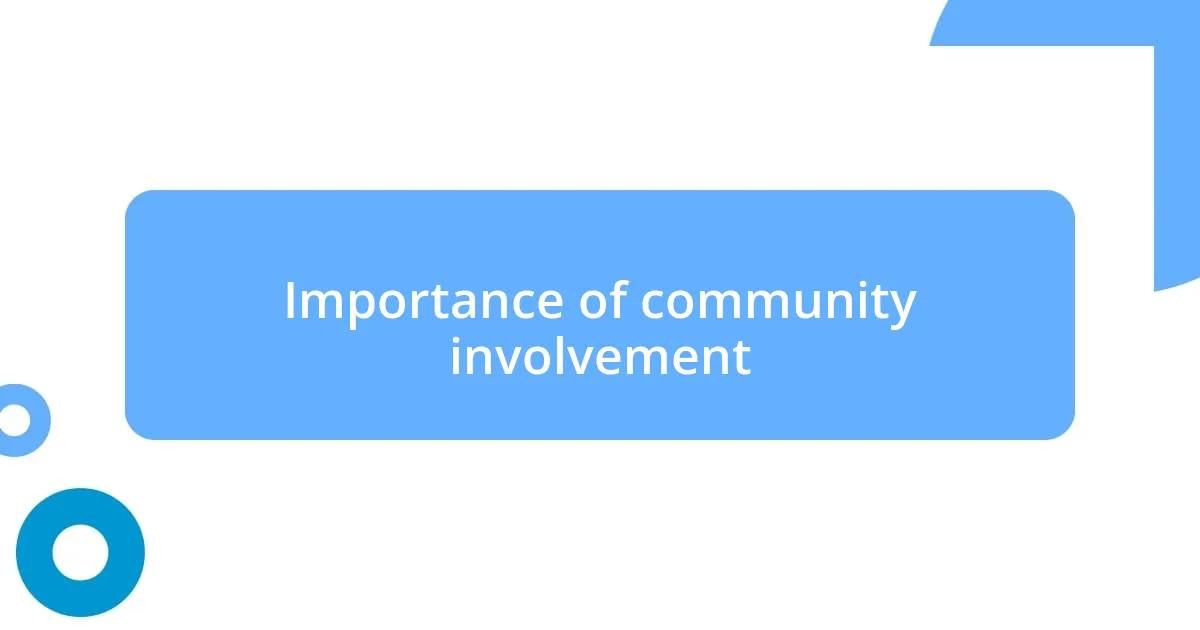
Importance of community involvement
The importance of community involvement in budget frameworks can’t be overstated. I’ve witnessed firsthand the energy that comes from residents gathering to discuss their priorities. For instance, during a neighborhood meeting on park renovations, one parent passionately articulated the need for a safe play area for children. This personal connection to the budget truly illuminates how vital community voices are—budgets become relevant only when those affected by them contribute.
- Active participation fosters transparency and trust in decision-making.
- Engaged communities can identify unique local needs that may otherwise be overlooked.
- Collaborating with residents leads to innovative solutions that reflect genuine desires and aspirations.
- When people feel heard, their commitment to community initiatives strengthens, creating a more invested populace.
- Shared responsibility encourages individuals to advocate for equitable resource distribution, ensuring everyone benefits.
Every time I see members discuss their needs and aspirations, it ignites a spark in me. It’s as if I can feel the heartbeat of the community; their ideas take form and find a place in tangible projects. Imagine the difference this could make if everyone had the opportunity to influence budgeting decisions.
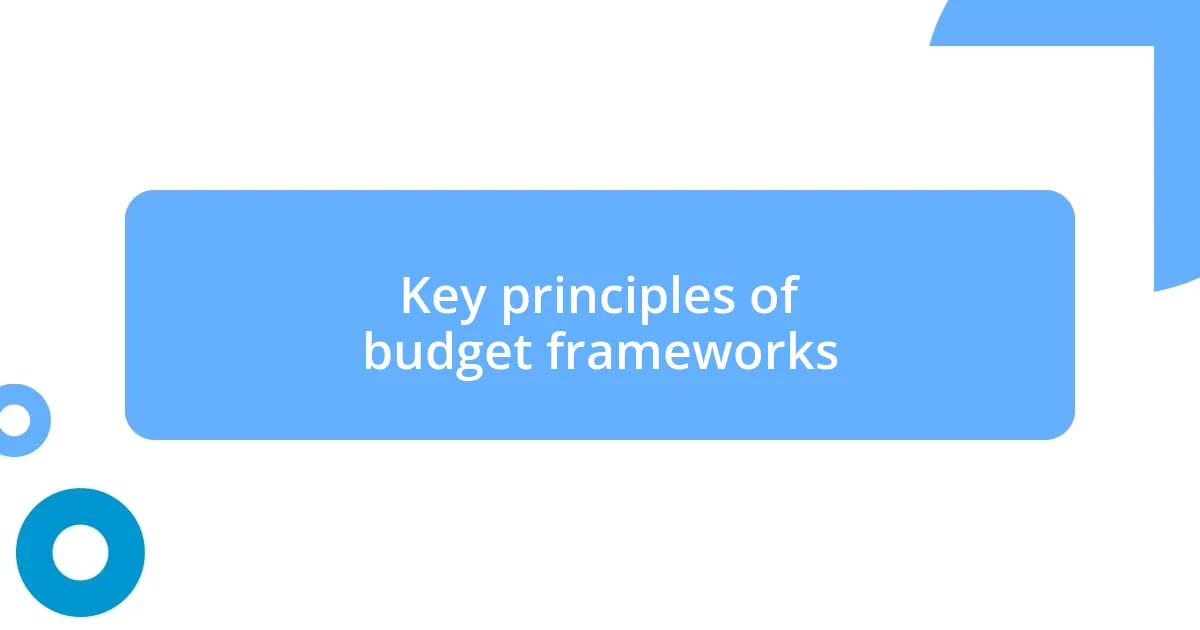
Key principles of budget frameworks
The principles behind budget frameworks are essential in creating a system that truly serves the community. One key principle is stakeholder engagement—bringing diverse voices into the conversation. A few years ago, I attended a forum where various community leaders discussed funding allocations. Listening to a local chef express the need for resources to support culinary training for youth opened my eyes to how specific projects can arise from sincere community needs. This principle has a profound impact; it makes budgets a living document that evolves with input from those affected.
Another critical aspect is accountability. Holding decision-makers responsible for their actions fosters trust and commitment within the community. During a budget hearing, I was moved by how residents questioned allocated funds for public services. Their willingness to challenge discrepancies made it clear that true accountability breeds empowered citizens. It reminded me that when residents feel invested in financial decisions, they are more likely to contribute to community initiatives and advocate for accountability as well.
Furthermore, the principle of adaptability allows budget frameworks to respond to changing circumstances. I recall when a natural disaster struck our town—those who had worked on flexible budget frameworks were able to swiftly redirect funds towards emergency relief. This responsiveness not only met immediate needs but also demonstrated resilience. Incorporating adaptability into budgeting ensures that resources can pivot toward pressing community issues when they arise.
| Key Principle | Description |
|---|---|
| Stakeholder Engagement | Involves diverse community voices in decision-making to reflect real needs. |
| Accountability | Ensures decision-makers are responsible for financial choices, fostering trust. |
| Adaptability | Allows budgets to respond effectively to changing community circumstances and needs. |
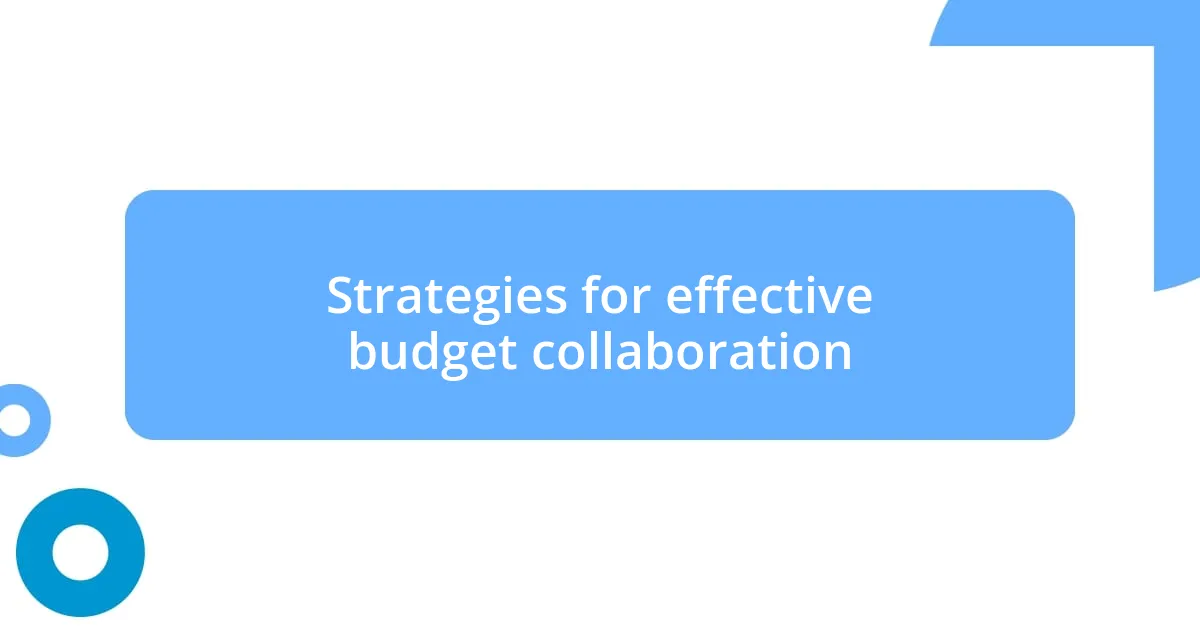
Strategies for effective budget collaboration
Effective budget collaboration hinges on creating spaces for open dialogue. I remember sitting in a community workshop where residents shared not just their needs, but their stories. It struck me how powerful those narratives can be in shaping budget priorities. Have you ever felt that a discussion could lead to real change? That’s the kind of energy I see when people come together for budget talks—shared experiences spark innovative solutions that wouldn’t surface in isolation.
Moreover, utilizing technology can amplify collaboration efforts. A few months ago, I participated in a virtual budget discussion using an online platform designed for inclusive feedback. The convenience encouraged participation from those who typically might shy away from in-person meetings. It made me reflect: what if every community could harness technology to ensure every voice is heard? By adopting digital tools, we can break down barriers and foster a sense of belonging in the budgeting process.
Lastly, implementing structured feedback mechanisms can transform how communities interact with budgets. After a local project, I asked attendees how they felt their input had been used. The responses were enlightening—some felt their ideas were acknowledged, while others wanted clearer communication on outcomes. This feedback loop is vital; it creates an environment where citizens feel genuinely engaged and empowered. As I listened, I realized that when we cultivate a culture of feedback, we not only improve future collaborations but also strengthen the bonds within our communities.
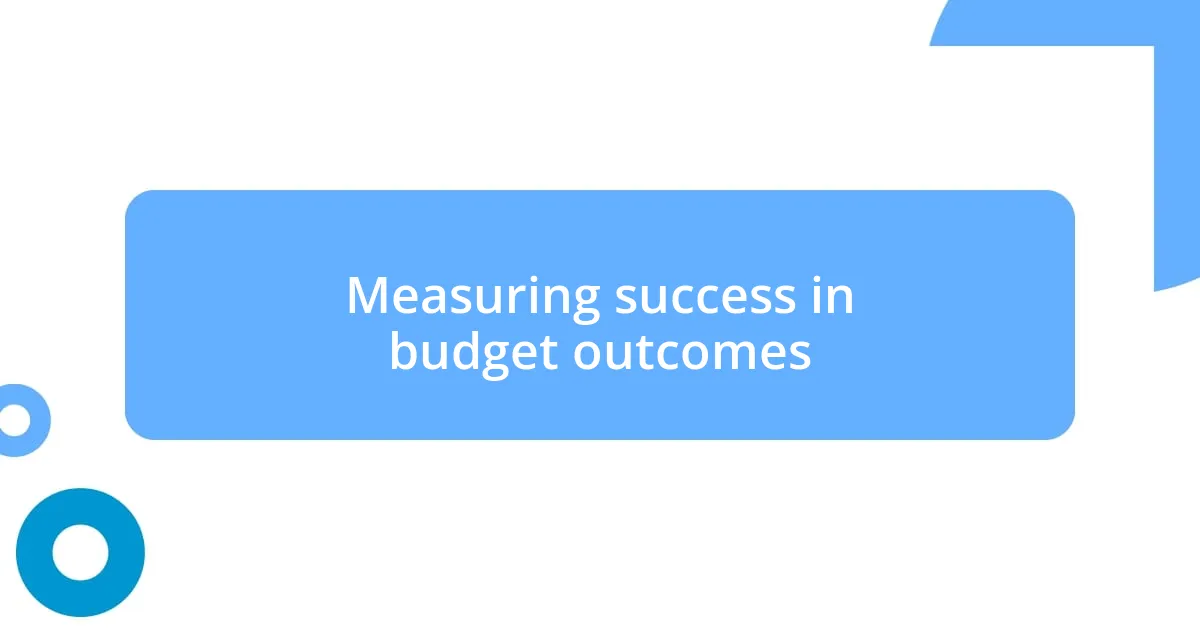
Measuring success in budget outcomes
When it comes to measuring success in budget outcomes, one essential factor is the tracking of key performance indicators (KPIs). I recall a community development project I was part of where we established specific metrics, like the number of youth job placements after a training program. This clarity opened my eyes to how quantifying success can direct focus on tangible results, rather than vague aspirations. It also encouraged community members to rally around common goals—after all, people respond better when they see real progress.
Another method that stands out to me is the importance of qualitative feedback. In one instance, after implementing a new public transportation initiative, we gathered community stories from riders about their experiences. Their narratives provided insights that numbers alone couldn’t convey. Have you ever noticed how a single personal story can resonate more deeply than a flat statistic? By weaving these narratives into our assessments, we created a more holistic view of success that truly reflected the community’s feelings and needs.
Lastly, regular community forums for discussing budget outcomes have proven invaluable. During one such gathering, a resident candidly shared her disappointment over a lack of improvement in local parks, despite budget allocations. This moment of vulnerability reminded everyone present of the real-world implications of financial decisions. It solidified my belief that measuring success is not merely about collecting data, but also about fostering a culture of open dialogue where everyone has a chance to voice their experiences. How else can we genuinely understand the impact of our budgetary choices if we don’t listen?
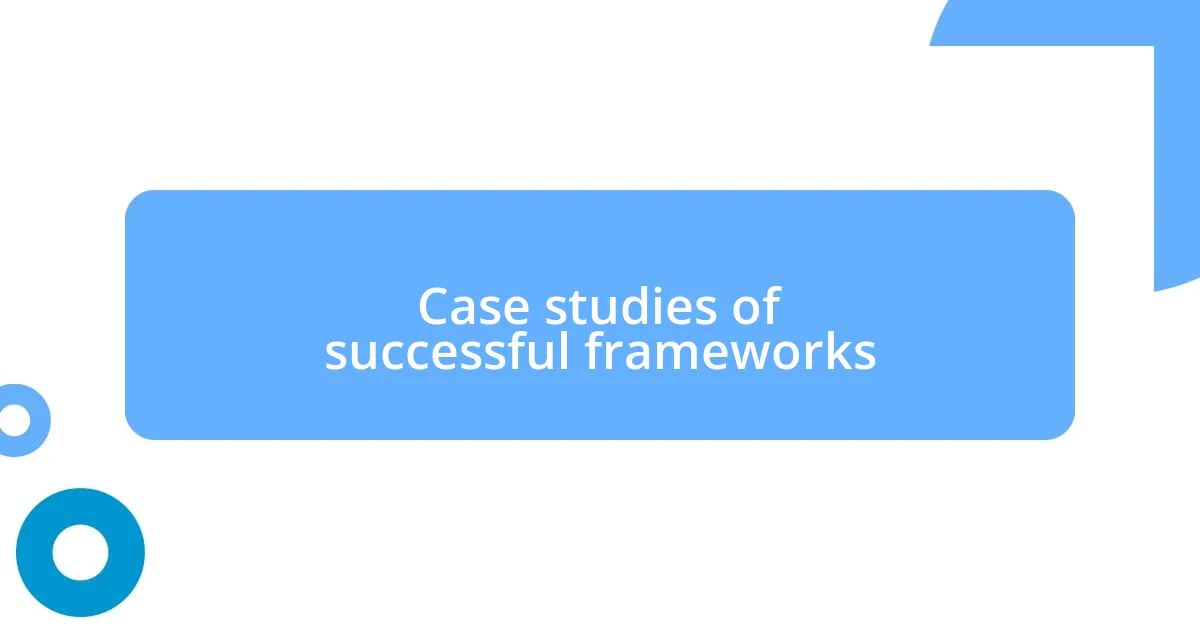
Case studies of successful frameworks
One of the most striking examples of a successful community-centric budget framework was in a small town where residents were invited to co-create the budget through participatory budgeting sessions. I remember attending one of those sessions, where the room buzzed with anticipation and ideas. It was amazing to witness community members vote on projects that mattered most to them, like a new playground and local arts initiatives. This direct involvement made not only the outcomes more relevant but also fostered a sense of ownership that I believe is crucial for long-term commitment to community projects.
Another case that has stuck with me was a citywide initiative that leveraged social media to gather community input on budget priorities. A friend of mine spearheaded this effort, and seeing how excited people were to share their opinions was truly inspiring. They created a simple, user-friendly survey that allowed anyone to voice their concerns and aspirations for local spending. The success of this approach was evident: participation rates soared, and the feedback was diverse. Have you ever noticed how digital platforms can unravel this hidden treasure trove of ideas? It confirmed for me that when we open up avenues for dialogue, we not only enrich the budget process but also deepen community ties.
Lastly, I can’t help but think about an innovative framework implemented in a neighboring community that focused on environmental sustainability in budgeting decisions. During a forum, community leaders showcased how their budget allocations reflected ecological priorities, like urban green spaces and renewable energy programs. My heart swelled with pride when they shared stories of how these initiatives reduced local pollution and enhanced quality of life. It made me wonder: how often do we align our budgets with values that truly resonate with our community’s needs? This case study highlights how budgets can do more than just financial transactions—they can truly transform our shared living spaces for the better.
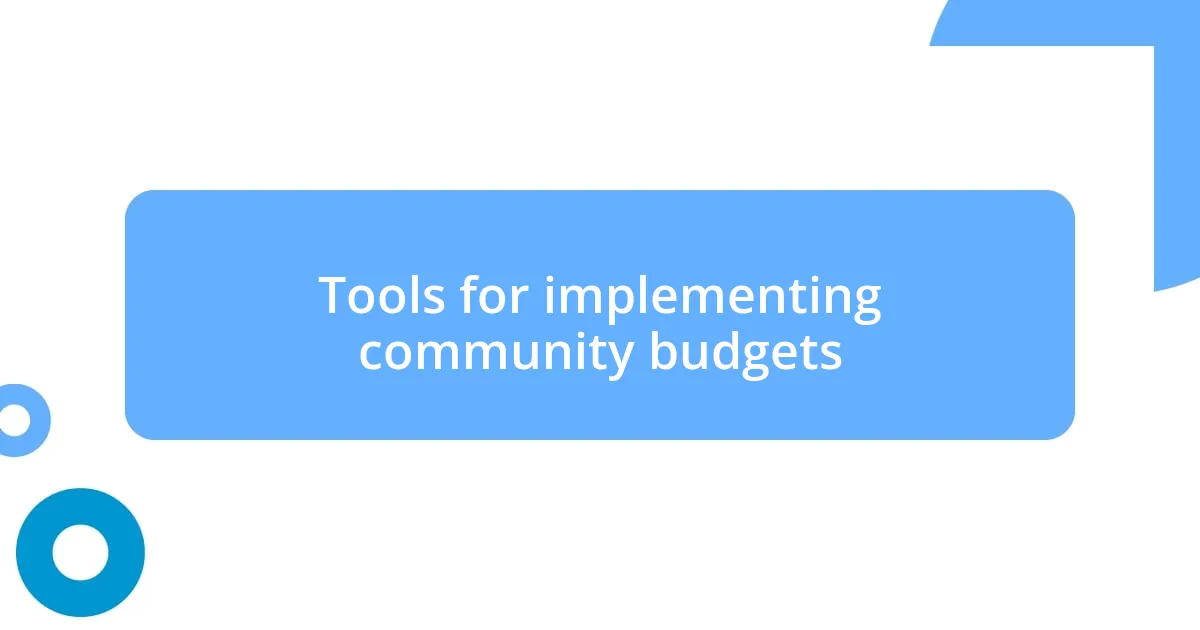
Tools for implementing community budgets
One of the most effective tools I’ve encountered for implementing community budgets is collaborative software designed specifically for participatory budgeting. During a workshop I facilitated, we used such a platform to allow residents to propose and discuss projects in real-time. Seeing the engagement as locals brainstormed initiatives together made it clear that technology can bridge gaps and inspire collective creativity. Have you ever felt that rush when a good idea emerges from a group? That’s exactly what happened as the energy in the room shifted from passive observation to active participation.
Additionally, visual mapping tools can be game-changers. I recently worked with a group that used an interactive map to visualize budget allocations across the community. As we laid out projects on the map, I saw neighbors’ eyes light up with recognition as they connected dots between funding and physical developments in their neighborhoods. It struck me how a simple visual representation could lead to deeper discussions about equity and access. How often do we overlook the power of visuals in conveying complex information?
Lastly, I feel it’s worth highlighting the role of community liaisons. In one project, we appointed local volunteers to serve as budget ambassadors, fostering a direct line between residents and decision-makers. Their grassroots efforts made all the difference. I recall chatting with one of these liaisons who passionately shared how residents felt empowered to communicate their needs directly. It reinforced my belief that when we empower individuals to act as conduits for information, we nurture a collaborative spirit that strengthens the entire budgeting process. Isn’t it incredible how one person’s enthusiasm can ignite a community’s engagement?












